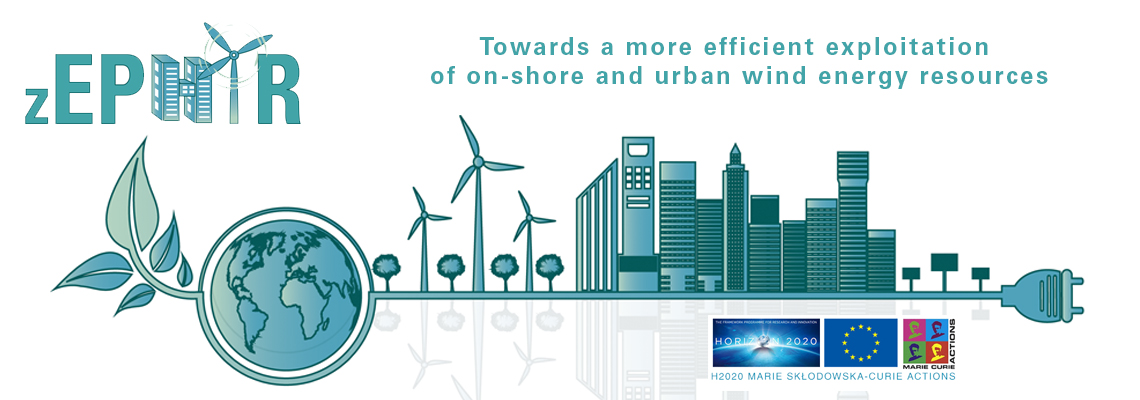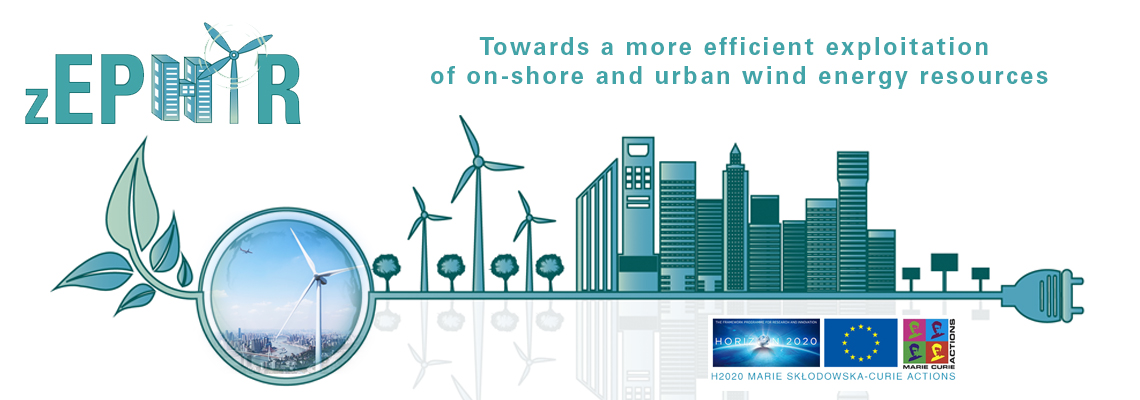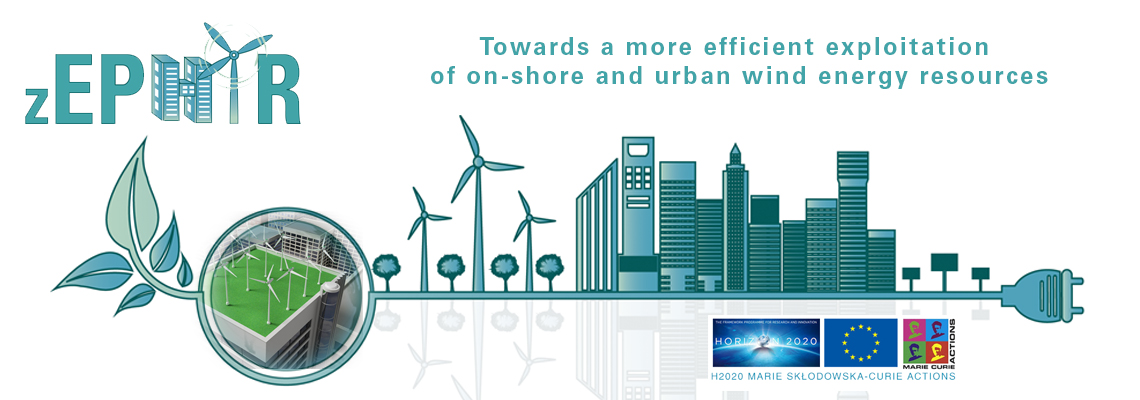Sidebar
The rise of a low-carbon society, compatible with economic growth and environmental sustainability, is pending on a number of technological evolutions and breakthroughs. In that line, the role played by wind energy is deemed to increase further in the next decades. The development of performant wind farms is pending upon the performance of each turbine composing the wind farm, and on the optimal harvesting of the local wind resources. A wind park performance is nowadays predicted assuming standard profiles of mean incoming velocity, turbulence intensities and scales, etc. corresponding to standard terrain topographies and atmospheric conditions.
One main limitation of such standards is that the assumed flow and turbulence properties were established to fit databases gathered on a limited number of locations, which are by definition not representative of the quite various terrain configurations nor local micro-meteorological situations that can be met in practice. This is a concern for complex terrains and is furthermore hampering the implementation of wind turbines in urban environments, which constitutes nevertheless an important component of future environmentally-friendly Smart Cities thanks to the favorable local flow accelerations, pressure build-up, canyon effects, etc. offered by an urban canopy.
The ambition of this multi-disciplinary training platform is the development and application of advanced meso/microscale atmospheric models and the assessment of the impact of real terrain and local atmospheric effects on the predicted aerodynamic performance, structural dynamics and noise emissions. Obviously, human factors become a critical issue when considering implementing wind turbines in densely populated urban environments. The inter-dependencies between those factors (visual vs. acoustic effects, age or occupation, etc.), which complicate further the analysis of the motivations for a community to endorse or reject a new project, will be addressed as well.
The coordinator of the project is Dr. Sophia Buckingham from the von Karman Institute for Fluid Dynamics and the deputy coordinator is Professor Leandro Dantas De Santana from the University of Twente.
The partners of the project are Valeo Systèmes Thermiques SAS (VAL), Dedan Kimathi University of Technology (DKUT), Enerall srl (ENE) and Université de Sherbrooke (UdeS).
The beneficiaries are von Karman Institute for Fluid Dynamics (VKI), Universiteit Twente(UTW), National Technical University of Athens (NTUA), Siemens Industry Software nv (SISW), Samtech SA (SAMTECH), Wageningen University (WU), Technische Universiteit Delft (TUD), Universidad Politécnica de Madrid (UPM), Siemens Gamesa Renewable Energy AS (SGRE), The Nottingham Trent University (NTU), Universidad Nacional del Litoral (UNL), Centre Scientifique et Technique du Bâtiment (CSTB).
This project has received funding from the European Union’s Horizon 2020 research and innovation programme under grant agreement No 860101.


Objectives
zEPHYR has the following objectives:
- Foster a training-through-research network of young researchers, where the ESR fellows will investigate and further develop promising emerging technologies enabling a more efficient harvesting of wind energy resources in ‘conventional’ on-shore as well as urban environments through more accurate and robust simulation methodologies, supported by laboratory experiments and theoretical models, and applying novel optimization approaches.
- Bring in a coordinated research environment top-rank academia, research centres and industrial stakeholders, actively involved in top-level research in the fields of fluid dynamics, aeroacoustics, structural dynamics and fatigue life prediction, Uncertainty Quantification, optimization methods, system dynamics and control, and human factors.
- Offer an unprecedented training infrastructure where the young researchers will not only acquire the necessary scientific skills, but will also be confronted with the intricacies of an innovation process including integration, manufacturing, economical constraints, through strong interactions with the industrial world.
Two on-shore application areas will be considered:
i) horizontal axis wind turbines (HAWTs) with sizes corresponding to the current state-of-the-art (~ 5-10 MW), and
ii) urban wind turbines, with a focus on the most promising concepts for urban integration such as vertical axis wind turbines (VAWTs), diffuser-augmented wind turbines (DAWTs) and building-integrated wind turbines (BIWTs).
Besides the aerodynamic performance and durability issues that are raised by the specific flow features of urban environments, the successful deployment of green Aeolian energy in cities will crucially depend on the visual and acoustic annoyance aspects, affecting the societal acceptance of such novel concepts.

Factors
As a matter of fact, it now appears to this consortium that the efficient exploitation of available wind resources is hindered by several factors:
- In absence of accurate atmospheric data with sufficient temporal and spatial resolutions, one cannot predict reliably the performance, durability and noise emissions of wind turbines. This is particularly acute for the development of a wind farm, which energy harvesting could be significantly improved through a more accurate and detailed prediction of the mean and unsteady wind characteristics of a given site. A very promising perspective in that respect is opened by the simultaneous development of high-fidelity scale-resolved simulation techniques and the rise of available computational power. The required mesh resolution combined with the dimensions of the simulation domain can easily lead to unmanageable computational costs, but novel simulation techniques described below permit nowadays to resolve this issue, opening the possibility to represent accurately a specific topography and associated accelerations, separated flows, etc., while accounting for seasonal or diurnal/nocturnal variations of the wind direction, atmospheric stability, etc.. The starting line of this project is the development and application of advanced atmospheric models and the assessment of the impact of real terrain and local weather effects on the aerodynamic performance, structural dynamics and noise emissions.
- Due to the same limitations, the variability of the local flow field experienced by a wind turbine due to atmospheric, topographic, seasonal, diurnal/nocturnal and other variables cannot yet be assessed systematically. Besides, the above-mentioned parameters and resulting flow field predictions are inherently associated with uncertainties. Variability and uncertainty effects must be accounted for to attain an optimal and robust exploitation of local wind resources.
- The integration of large scale wind farms may cause impacts on system operation and stability of power grids . The specific intermittency of wind energy imposes the need for a precise estimation of the wind power accommodation capacity of the global system, to make the most of wind energy . The problem is complex as it involves the wind power characteristics, power system flexibility, transmission line capacity, grid control strategies and policies that apply at the scale of a continent. But in the end, the primary input parameter is the estimation of the wind resources intermittency, which requires better atmospheric models coupled to the WT power curve.
- Noise is assessed in terms of dB(A), which merely reflects the human sensitivity variation with frequency, but doesn’t represent the complex perception issue related to transient features of the acoustic emissions (e.g. the periodic ‘swishing’ or ‘swooshing’ noise due to directivity and Doppler effects, or the faster modulation due to the ingestion of large-scale atmospheric turbulence). Besides, the inter-dependencies between human factors (visual vs. acoustic effects, age or occupation, etc.) complicate further the analysis of the motivations for a community to endorse or reject a new project. It turns out that human factors are still quite poorly quantified.
- Simply, the available space is shrinking in some densely populated countries. It becomes crucial to make the best possible use of the remaining available areas in those countries. In that line, the potential of urban environments has been largely ignored so far, while offering very interesting perspectives. The local wind profiles above an urban canopy present very favourable characteristics in terms of local flow acceleration, pressure build-up, canyon effects, etc, which aren’t exploited. Obviously, the human factors evoked in the previous point become a critical issue when considering implementing wind turbines in densely populated urban environments.
Clearly, addressing the above issues requires a very comprehensive approach. A key difficulty thereto is the quite complex interlacing of multi-physical aspects (aerodynamic, structural, acoustic, etc.), which cannot be tackled separately. In that respect, progress is somewhat undermined by the classical engineering education system, where scientific teaching is rather fragmented discipline-wise. As a result, freshly graduated engineers are lacking the multi-disciplinary background that is necessary to tackle these challenges and propose innovative technologies. More specifically, freshly graduated engineers show an insufficient knowledge about the possibilities that are nowadays offered by new optimization techniques, robust design based on Uncertainty Quantification and other rapidly emerging fields such as Big Data and machine learning, to account for variable and/or uncertain input parameters. While it is acknowledged that those advanced techniques will become part of the corpus of methods that must be mastered by young engineers, they are rarely taught at university level.



